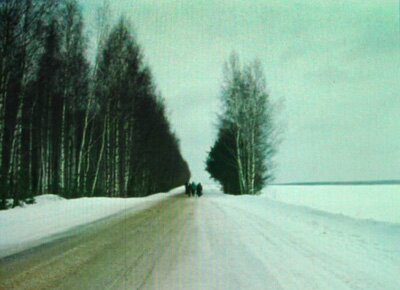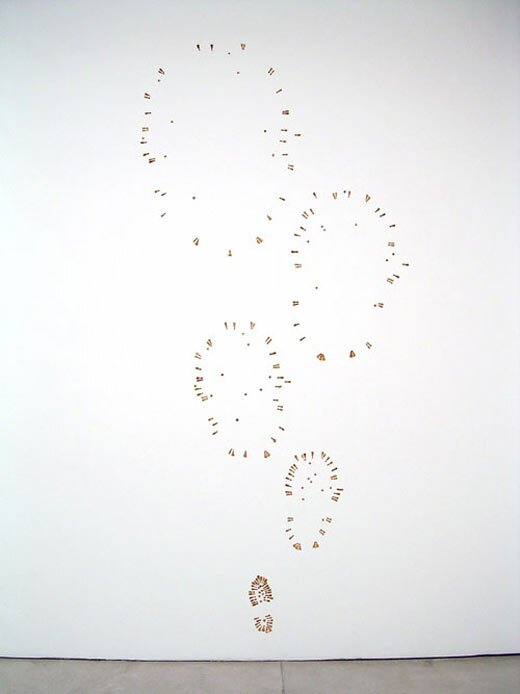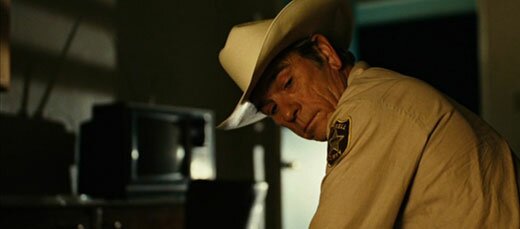video/film
Archived Posts from this Category
Archived Posts from this Category
Posted by ben on 23 Apr 2008 | Tagged as: performance art, responses/reviews, video/film
I have a piece in last week’s Current discussing the work of Regina José Galindo (currently at Artpace). It’s not so much a review as a discussion of the history of Galindo’s work, and the way that it brings protest strategies into a visual art context. There’s a lot I couldn’t get to in that article, though, and thought I might dig into that a little bit here.
One thing that struck me about the work at Artpace is the contrasting uses of performance and documentation by Kate Gilmore, Regina José Galindo, and Margarita Cabrera. (Although Rodney McMillian incorporated performance and documentation into his work, for various reasons I won’t be discussing him in this post.) Galindo’s performance draws from a protest tradition — at Artpace, she locked herself along with her husband and daughter in a mobile prison cell in the gallery. Also, like a protester, she views her performances as her artwork, while the videos and photographs that are generated from them are purely documentation of the performance — not individual works of art, but necessary to spread “word of the performance and the message.” However, when she discusses her intentions and expectations, Galindo never mentions social change:
I suppose that—like everything I do—this was done for me…. I never have any expectations after completing something. What I do have is a certain amount of nervousness and anxiety before every performance. But after that I have no expectations. It’s done.
So in this way at least, it is distinct from protest which aims to catalyze social change.
Like Galindo, Kate Gilmore puts herself into dangerous or difficult situations in order to comment from a personal perspective on the systemic problems that prevent human progress. But the similarities end there. Gilmore’s work consists of performances on video (the videos being, in this case, the artworks, while the performances become simply part of the process of creating the work). The situations Gilmore puts herself in don’t target material injustices, but are created by the artist. She sets her foot in a bucket of cement, lets the cement dry, and then sets about the task of breaking her foot out of the cement with a hammer. This kind self-imposed task suggests an allegorical confrontation with psychological barriers more than a way to address specific injustices (although these barriers are connected to societal inequities).
Margarita Cabrera takes a different tack. She turns the gallery space into a makeshift copper butterfly factory, and recruits community volunteers to make 2,500 butterflies by hand. This strategy recalls the work of Harrell Fletcher, who often addresses divisions within communities by organizing collaborative events. However, Cabrera does, like Galindo, deal with concrete issues of ongoing social injustice. The workshop Cabrera builds is meant to signify the maquiladoras (low-wage manual labor factories, often with lax labor law enforcement) in Mexico. By “exporting” the butterflies to the home of a wealthy San Antonio collector, Cabrera targets economic systems that hide the human costs of a product from its owners by separating the craft from the craftsman. The documentation plays a minor role in this work: a photograph of the butterfly installation is affixed to the wall of the workshop. In another parallel to Galindo’s work, Cabrera leaves the workshop for gallery visitors to explore, so that a trip to the gallery gets you an experience of the residue of her artwork.
The interplay between these exhibits helps flesh out the contours of performance in contemporary art. Each artist works with performance strategies that articulate a distinct relationship between artist and community. By placing these shows side-by-side, Artpace encourages the visitor to contemplate approaches to social critique: The direct, literal commentary of Galindo, or the allegory of Gilmore. The interpersonal relations of Cabrera or the personal goals of Galindo. The roles of document and sediment in the artistic process.
Posted by michelle on 25 Mar 2008 | Tagged as: art paparazzi, video/film
Blaffer Gallery Curator Claudia Schmuckli invited French filmmaker Chantal Akerman to show five works, including a new film/video installation project commissioned by the University of Houston. The show closes in four days so I wanted to highlight a clip from one of the pieces in “Moving Through Time and Space.” To read a thoughtful review of the show visit our neighbors.
Enjoy one of many beautiful stills from the show:

Posted by ben on 07 Mar 2008 | Tagged as: announcements, essays, responses/reviews, sneak peeks, video/film
The new issue of Art Lies should be hitting your favorite news stand soon; but they already posted it online, including my review of the Triangle Project Space tps show Standing on one foot, and an interesting conversation between San Antonio’s Potter-Belmar Labs (Leslie Raymond and Jason Jay Stevens) and Oakland’s Double Archive (Chris Kubick and Anne Walsh). Enjoy!
Posted by ben on 03 Mar 2008 | Tagged as: performance art, sound art, tv, video/film
Some enterprising movie nerds have traced the history of a stock scream sound effect now known as the “Wilhelm Scream” (the original title in the Warner sound effects archives was “Man Being Eaten by Alligator”). The sound effect has been used in over 75 movies, including all the Star Wars and Indiana Jones movies, as well as a number of TV shows and even video games.
This is an interesting counterpoint to a performance by Chris Kubick and Anne Walsh at UTSA last spring, which paired movie sound effects with their titles from the stock sound effect catalogs. Kubick and Walsh built collections of comparable sounds such as various recordings of ringing bells or galloping horses and created a program that projected the name of each sound effect as it was being played, showing the huge variety of linguistic associations that can be made with very similar sounds.
(via The Plank)
Posted by ben on 22 Feb 2008 | Tagged as: performance art, video/film, vs.
Bruce Nauman, Walking in an Exagerated Manner around the Perimeter of a Square (1967-68)
Monty Python, The Ministry of Silly Walks (1970)
Posted by ben on 03 Feb 2008 | Tagged as: music, poetry, video/film
The opening scenes of Bela Tarr’s brilliant Werckmeister Harmonies (music by Víg Mihály):
Posted by ben on 24 Jan 2008 | Tagged as: music, responses/reviews, sound art, video/film
Argentine artist Jorge Macchi has been all over South Texas lately — he was a resident at Artpace in 2005, he currently has a piece in the Triangle Project Space’s Standing on one foot, and the Blanton is showing Anatomy of Melancholy, his first “comprehensive U.S. exhibition,” through March 16.
As I wandered through the Blanton exhibit, I was reminded of the scene in The Breakfast Club when Allison (the “psycho” girl) puts on makeup and everyone realizes she’s a fox. Jorge Macchi has put in a lot of effort giving Fluxus a shave and a haircut, and what do you know, it fits very nicely into a standard gallery format. Macchi’s Caja de música, for instance, draws on the chance operations that ’60s experimentalists picked up from John Cage. Taking video of cars on a 5-lane highway, Macchi assigns a musical note to each lane, and as a car enters the frame the note corresponding to the lane it is in plays, creating a kind of randomized music box (you can watch this video on his site).

He’s also very fond of finding the edges of things, the demarcations, and focusing on those rather than the intended content of an appropriated work. For instance, at his Artpace residency, he took the final moments of several old movies and created video loops of the “The End” sequences. In an analogous move at the Blanton show, he cuts everything out of a map except the graveyards. These pieces draw our attention to the liminal moments, the insecurity of transition. Despite the summoning of these precarious situations, though, Macchi’s work feels very comfortable. He’s taken the ideas pioneered by Dada and Fluxus artists, art based on the awkward and the random, smoothed out the edges and made it feel very safe within the white walls of the museum.

There are some very elegant pieces in the Blanton show, including Caja de música, and Fuegos de artificio, a piece in which footprints made of soil expand outward on the wall, progressively losing their form like ripples on a pond. This is a concise and beautiful statement about the impact we have on the world as we move through it, bringing with us the dirt of another place, which gradually loses the significance of having come from our shoes.
But I’m left wondering whether the ideas Macchi draws from are best expressed with the sort of finesse and refinement he brings to them. Maybe the chance operations of Arp, Cage, Maciunas and all the others are better left in a raw form. Maybe Allison was hot without the makeup.
Posted by ben on 04 Jan 2008 | Tagged as: books, video/film
I used to post a lot more experimental cinema on Emvergeoning, digging through YouTube when I couldn’t think of anything interesting to write about. Examples include films by Phill Niblock (of a Sun Ra performance), Edgar Varèse (Poème électronique), Nam June Paik and Jud Yalkut (Electronic Moon #2), Piotr Kamler (Une Mission Ephemere), Harry Smith (Color Study), and others.
For those of you who miss those days, Andrew of The Expanded Field just pointed out a blog devoted entirely to experimental video and film called Expanded Cinema (which is also the title of a great book on the subject). Just thought you might want to know.
Posted by ben on 13 Dec 2007 | Tagged as: comics, video/film

Check out some great images (and video) of Mike Kelley’s new installation at Jablonka Galerie, which deals with the representation of Superman’s home town, Kandor, in the DC comic books. This press release explains the show more fully.
Posted by ben on 02 Dec 2007 | Tagged as: responses/reviews, video/film

A friend pointed me to this excellent analysis of the end of the new Coen brothers movie (obviously, there are spoilers) by film critic Glenn Kenny. Kenny does a good job of pointing out divergences from the novel on which the film is based in order to pinpoint the significance of the Coens’ ending. He also does a fine job of putting the final scene into historical context. And for good measure, here’s a rebuttal from Alicublog. I tend to side with Kenny on this one (who apparently considers the film a masterpiece), although I’ll have to see it again before taking a strong position. Throughout the work the Coens refuse to show you what you want to see, ultimately transforming a thriller into an elegy. The question of whether this is a great film hangs on whether the transformation is successful, or is an overreach, an unraveling. That question’s not so easy to answer on just one viewing.
Posted by ben on 18 Nov 2007 | Tagged as: art paparazzi, video/film
Is Damien Hirst working on the new Indiana Jones movie? Or is this some stunt by Saatchi to make sure everyone knows that crystal skulls are hot?
Posted by michelle on 24 Oct 2007 | Tagged as: video/film
Posted by ben on 04 Sep 2007 | Tagged as: performance art, video/film
Posted by ben on 13 Aug 2007 | Tagged as: music, rock!, video/film
I knew I had to find the antidote to that Hall & Oates video, and I think this is it. Mike Cooper has been one of my favorite musicians lately, embracing blues, free jazz, experimental electronics, and even exotica — and yet his recordings never sound contrived. Here’s a video for a recording he did back in 1984 with Tim Hill, Gary Jones and Paul Burwell (as Beating Time). This fits somewhere in the No Wave / Free Jazz Fusion territory…. Be sure to check out too.
Posted by ben on 31 Jul 2007 | Tagged as: r.i.p., video/film

Now the news comes that Ingmar Bergman and Michelangelo Antonioni both died yesterday. While I have found much to admire in Bergman’s work, Antonioni will always hold a special place in my heart. I considered his film Il Deserto Rosso (Red Desert) to be the pinnacle of art for a period in my adolescence. It is a near-perfect expression of the disconnection, emotional instability, and confusion of this stage of life. But more than that, I think that this may have been the first work of visual art that made me understand how powerful the intersection of aesthetics, psychology, and philosophy could be. Of course it is not just visual — the poetry of the dialogue, the strangeness of the music, the striking imagery, combine to express not just a mood, but a metaphysical statement.
At the end of this film, the main character (played by Monica Vitti) tells a story to her daughter:
“There was once a little girl who lived on an island. Being with adults bored and frightened her. She didn’t like kids her own age because they pretended to be adults. So, she was always alone playing with cormorants, seagulls, and wild rabbits. She had discovered a tiny beach far from the village, where the sea was transparent and the sand pink. She was so silent there. She would leave when the sun disappeared. One morning she saw a sailboat. It was different from the other sailboats that usually passed by. This was a real sailing ship! One which must have seen all the oceans and storms and had maybe gone around the world. From afar it was magnificent. Up close it was mysterious, with no one to be seen on board. For a while it was motionless. Then it turned and sailed out as it had come in. The little girl, used to man’s strange mentality, was not really surprised. But, as she turned away… wait. One mystery was perfectly normal… but two? Who was singing? The beach was deserted, as usual, yet the voice was there… now closer, now further away. At one point it seemed to be coming from the sea. Beneath the rocks… many small rocks… that she had never noticed… and they looked human. And at that moment the voice was very soft.”
“But who was singing?”
“They all were singing.”
Update: Sorry, I can’t help it. I just came across another quote from this film. This one always gave me goosebumps.
Giuliana: I feel my eyes tearing up. What should I do with my eyes? What should I watch?
Corrado Zeller: You ask what you should watch. I ask how I should live. It’s the same thing.
Posted by ben on 18 Jul 2007 | Tagged as: performance art, silliness, video/film
A lot of you have probably seen this, but it is too funny to pass up. Plus it’s time for a new post, and I have nothing to say. (A post on Alberto Mijangos’ T-shirt series is forthcoming, however…)
Posted by ben on 05 Jul 2007 | Tagged as: essays, video/film

When I first saw Mike Gravel’s on YouTube, I figured he was just a 3rd tier Democrat trying to leverage Dadaism to get a little publicity. Crispin Sartwell has decided that these ads are no mere publicity stunt, but the genuine avant-garde of campaigning: “These are Dadaist campaign ads, as revolutionary in their context as Duchamp’s urinal, Warhol’s Marilyns, Washington crossing the Delaware, Bugs Bunny’s attack on Elmer Fudd.” You may never again see someone reference Baudrillard while critiquing a campaign ad, so enjoy it while you can, if you can:
Gravel’s works confront us with our own existences and our deaths, the brute thereness of truth, the skull beneath the $400 haircut, the cellulite under the pants suit. His is neo-existentialist, post-apocalyptic, post-post modern art, a silence that screams and cajoles.
(via The Plank)
Posted by ben on 16 Jun 2007 | Tagged as: music, video/film
Phill Niblock film of Sun Ra’s Arkestra from 1966. A 16-minute version of this film has recently been released on DVD, and is . Niblock did a similar film of Arthur Russell, but it’s these days…